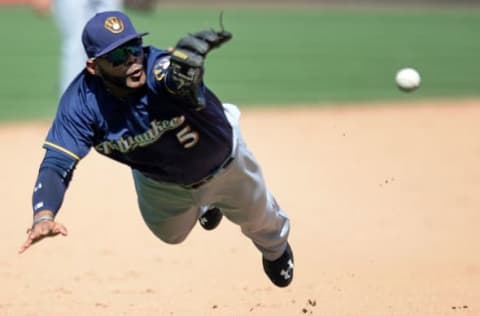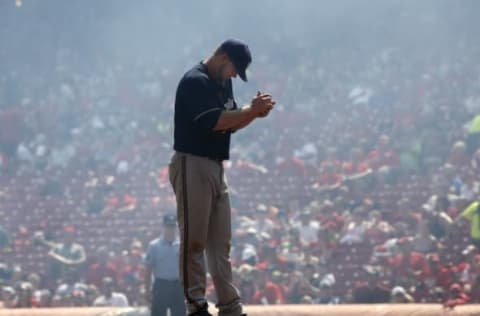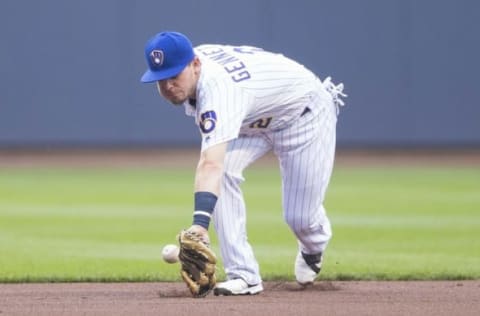Milwaukee Brewers 2016 Season Review


The Milwaukee Brewers finished the season with a 73-89 record, avoiding 90 losses, but still finishing 30.5 games out of first place.
The Good Stuff
Jonathan Villar – The Brewers acquired Villar in the offseason, assuming he would help to push uber-prospect Orlando Arcia and perhaps allow the team to give Arcia time in the minors if needed. Instead, Villar was fantasy baseball’s MVP on the season, earning more than any player in fantasy this year as he hit .285/.369/.457 with 60 extra base hits and 62 stolen bases, the latter number leading the entire league. Villar did struggle some once Arcia came up late in the season and the Brewers moved him to third base, but he’s got the range and arm to handle third base just fine with an offseason to prepare for the move. Villar also struck out 174 times. That will need to clear up going forward, but there are certainly great things to build on.
Unheralded Power/Speed Combos – The Brewers struggled to find guys at various spots around the diamond due to injury or poor performance, but a couple of the guys who emerged by season’s end in the outfield added to a trend around the team of having solid power/speed numbers. We’ve already discussed Villar and his major-league leading stolen bases along with solid power, but the Brewers also got two other prominent power/speed combinations in their lineup that no one would have predicted in March of last year.
Hernan Perez has been a utility man that has bounced from Detroit to Milwaukee. He had one career home run and 6 steals in 350 plate appearances before 2016. Then with the Brewers this season, he hit 13 home runs and stole 34 bases while hitting .272/.302/.428.
Alongside Perez in the outfield, Keon Broxton was a guy picked up in the offseason by Milwaukee who made a big impression. He started the season as the opening day center fielder, but after six games without a hit, Broxton was sent down to AAA until late May and then came back and struggled again, being sent down again in early July with a .125 batting average.
When Broxton came up in late July, he caught fire, and he simply was one of the best guys to own in fantasy baseball for the rest of the season. That final stretch was a slash line of .294/.399/.538 with 8 home runs and 16 steals over 46 games. His final line was .242/.354/.430 with 9 home runs and 23 steals on the year.
Junior Guerra – When plotting out how their rotation would shake out, I highly doubt that the Brewers were thinking that their best starting pitcher was going to be a 31 year-old rookie without electric stuff. Guerra went 9-3 over 20 starts and 121 2/3 innings with a 2.81 ERA and 1.13 WHIP, posting a 43/100 BB/K ratio. Guerra’s sinker/slider combo was working all season long, and he did a great job of suppressing hits. With better defense behind him, he very well could have done even better. Where he fits going forward and how much to believe in this production is yet to be determined, but it was a fun year to enjoy.
Bullpen – Coming into the season, many considered the bullpen to be one of the Brewers weak points on their team with an unsure closer situation and minimal experience in other parts of the bullpen. Jeremy Jeffress established himself as closer before he was traded away to Texas with Jonathan Lucroy and then Tyler Thornburg continued the excellent season he was having by taking over the closer role.
In middle relief, coming into the year, about the only definite spot in the bullpen was lefty Will Smith. He actually was more of a middling performer for the team once he lost the closer job in spring training, pitching to a 3.68 ERA in 27 games before he was traded to the Giants in midseason. However, Carlos Torres, who had been released by the Mets and the Braves from early February until the end of spring training, caught on with the Brewers and was a vital piece of the ‘pen, throwing 72 games with a 2.73 ERA.
The interesting part were the guys who came up and pitched well for significant stretches as older rookies or guys without much major league experience. Jhan Marinez, 28, had thrown 5 1/3 total innings in his major league career before 2016, yet after the Brewers purchased him from the Rays in May, he pitched in 43 games with a 3.22 ERA. Tyler Cravy, 27, made his debut as a long man in 2015, but focused more on straight relieving this year and had a 2.86 ERA over 20 appearances. Jacob Barnes, 26, made his major league debut and posted a 2.70 ERA over 27 games. Rob Scahill, 29, had been a journeyman that the Brewers grabbed off waivers from the Pirates and then posted a 2.45 ERA over 16 appearances for the team.
Next: The Bad

The Bad Stuff
Starting Rotation – As surprisingly good as the rotation was, outside of Guerra, the rotation was rough. Guys like Jimmy Nelson and Zach Davies had stretches where they were very good for a handful of starts in a row, but then they would go on stretches where they were putrid for a handful of starts. Matt Garza was fairly consistent at a 4.50ish ERA all season, finishing at 4.51. Wily Peralta was just ugly to watch pitch as he posted a 4.86 ERA.
Overall, the Brewers starters had one of the worst strikeout rates among all start staffs. On top of not striking guys out, they threw the highest percentage of balls (versus strikes) of any team in the league, with just over 38 percent of their pitches being called balls. That put extra taxing on their arms within at bats and gave the batter better opportunity to get a pitch that he needed to get a hit to move things forward for the opposing offense.
On the flip side, the Brewers were in a rebuilding mode, and they used a total of 9 starters on the year, the second least in the league, and that’s a positive thing to entrust your starters to go out their every turn of the rotation. What the team has in guys like Nelson, Davies, Chase Anderson, Peralta, and Guerra will need to be determined, however, as the next “wave” of young starters should start to hit the major leagues in 2017.
Inconsistency – In all seriousness, it’s really hard to describe what led to the Brewers being a near 90-loss team if you look at the plain numbers. Their offense was middle of the pack. The pitching was middle of the pack. The defense was rated poorly, but they were above a playoff team in defensive ratings on the season, so that alone wouldn’t have brought them down.
What really seemed to hurt the Brewers in 2016 was that they were doing exactly what they were supposed to be doing – rebuilding. They were playing a lot of young players to see what they had in them, and when you play a lot of young guys, you often get plenty of variance in play from day to day as that player adjusts to the league and then the league adjusts back, and so forth, for a few years to start the career.
As an example, a guy like Ryan Braun was a consistent performer for the Brewers this year, very possibly one of the only ones. He had a .305/.365/.538/.903 line on the season. If you look at his OPS numbers month by month, he doesn’t have a month higher than 1.015 or lower than .768. Overall he was consistent. However, when you dig deeper into his numbers, Braun hit 30 home runs on the season. He hit 10 of those home runs in August and 6 in September. So, through four months of the season, Braun had 14 home runs, but he finished with 30.
Injuries certainly led into things as well, and someone like Domingo Santana has solid numbers that were interrupted by injury. However, one of his former Astros teammates that he reunited with in Milwaukee, Chris Carter, was the definition of the inconsistency the team experienced from healthy players, as he posted a .922 OPS in April, a .686 in May, a .724 in July, and then .847 and .913 in August and September to close out the season. Carter had 40 home runs on the season, which in an even distribution over six months would be 6-7 per month. Instead, Carter finished with a flurry, hitting 11 home runs in September to hit his final tally.
When trying to win a series or put together a winning streak, a team needs consistent performances from multiple members of the lineup and the pitching staff to underscore those variant performances that would happen. A guy like Carter is just fine if you have someone that balances him out by hitting for solid production all season, even when Carter is struggling so his struggles don’t bring down the whole lineup.
Next: The Ugly

The Ugly Stuff
Defense – The Brewers finished in the bottom 5 in defensive ratings for infield and outfield on the season. Even Jonathan Lucroy before being traded was grading out below his normal excellent grades.
More from Call to the Pen
- Philadelphia Phillies, ready for a stretch run, bomb St. Louis Cardinals
- Philadelphia Phillies: The 4 players on the franchise’s Mount Rushmore
- Boston Red Sox fans should be upset over Mookie Betts’ comment
- Analyzing the Boston Red Sox trade for Dave Henderson and Spike Owen
- 2023 MLB postseason likely to have a strange look without Yankees, Red Sox, Cardinals
Moving Villar to third and bringing up Arcia will definitely help the left side of the infield. If Keon Broxton can give enough offensively to stay in the everyday lineup, he’s definitely the best center fielder on the major league roster, and moving him into center allows Domingo Santana to play right field, where his athleticism and strong arm will play up.
All that said, the team was still very inconsistent as mentioned before, so they’d need to focus on being consistent on the defensive side.
Strikeouts – No one in baseball struck out more than the Brewers this year, and they return most of those free swingers to the team in 2017. Some of the notable K rates: Keon Broxton 36.1 percent, Kirk Nieuwenhuis 33.9 percent, Domingo Santana 32.4 percent, Chris Carter 32.0 percent, Jonathan Villar 25.6 percent, Martin Maldonado 22.1 percent, Hernan Perez 21.9 percent, Orlando Arcia 21.8 percent, Scooter Gennett 21.0 percent, Ramon Flores 20.1 percent.
The Brewers do walk at a high rate as well, which is excellent, but strikeouts at that high of a rate will stifle offense in a hurry.
Taylor Jungmann – Jungmann has long been one of the “long-term” guys for the Brewers, since being drafted in 2011. He finally flashed in 2015 some of the promise the team had been waiting on all those years, throwing 119 1/3 innings with a 3.77 ERA and 1.28 WHIP along with a 47/107 BB/K ratio.
His 2016 was something to forget, however, as he made just eight appearances, throwing 26 2/3 innings with a 7.76 ERA, 1.76 WHIP, and a 17/18 BB/K ratio at the major league level. He couldn’t even get things straightened out in AAA, posting a 9.87 ERA and a 35/24 BB/K ratio over 31 innings at AAA. At 27 in December, he’s really beyond getting time from the team at this point.